Linear and Nonlinear Characteristics of Long-Term NDVI Using Trend Analysis: A Case Study of Lancang-Mekong River Basin
Abstract
1. Introduction
2. Materials and Methods
2.1. Study Area
2.2. Data Source and Preprocessing
2.3. Methods
2.3.1. Sen’s Slope Estimation and Mann–Kendall Significance Test
2.3.2. Hurst Analysis
- (1)
- Assume the time series , where t = 1, 2, …, n.
- (2)
- Construct the mean sequence of :where τ is a positive integer greater than t.
- (3)
- Calculate the cumulative deviation :
- (4)
- Calculate the range
- (5)
- Calculate the standard deviation :
- (6)
- Finally, calculate the Hurst exponent by the following formula:where is the proportional parameter. Consider that there is a constant H satisfying . This indicates a “Hurst effect” in the NDVI time series. H is the Hurst exponent value obtained by least squares fitting in the double logarithmic coordinate system.
2.3.3. BFAST Mutation Test
3. Results
3.1. Spatial and Temporal Pattern Analysis of NDVI in Lancang-Mekong River Basin
3.1.1. Time Change Analysis of NDVI from 2000 to 2021
3.1.2. Spatial Distribution Characteristics and Changes of the NDVI from 2000 to 2021
3.2. Trend and Mutation Analysis of NDVI from 2000 to 2021
3.2.1. Sen-MK Trend Analysis
3.2.2. Future Trends of NDVI
3.2.3. Nonlinear Mutation Analysis of NDVI
4. Discussion
4.1. Interannual Variation Analysis of NDVI
4.2. Spatial-Temporal Pattern of NDVI
4.3. Sen-MK Trend and Nonlinear Mutation of BFAST01
4.4. Limitations and Prospects
5. Conclusions
Author Contributions
Funding
Data Availability Statement
Acknowledgments
Conflicts of Interest
References
- Yang, S.J.; Song, S.; Li, F.D.; Yu, M.Z.; Yu, G.M.; Zhang, Q.Y.; Cui, H.T.; Wang, R.; Wu, Y.Q. Vegetation coverage changes driven by a combination of climate change and human activities in Ethiopia, 2003–2018. Ecol. Inform. 2022, 71, 101776. [Google Scholar] [CrossRef]
- Zhang, X.; Cao, Q.; Chen, H.; Quan, Q.; Li, C.; Dong, J.; Chang, M.; Yan, S.; Liu, J. Effect of Vegetation Carryover and Climate Variability on the Seasonal Growth of Vegetation in the Upper and Middle Reaches of the Yellow River Basin. Remote Sens. 2022, 14, 5011. [Google Scholar] [CrossRef]
- Chuenchum, P.; Xu, M.Z.; Tang, W.Z. Predicted trends of soil erosion and sediment yield from future land use and climate change scenarios in the Lancang–Mekong River by using the modified RUSLE model. Int. Soil Water Conserv. Res. 2020, 8, 213–227. [Google Scholar] [CrossRef]
- IPCC. Special Report on Climate Change and Land. 2019. Available online: https://www.ipcc.ch/site/assets/uploads/2019/08/4.-SPM_Approved_Microsite_FINAL.pdf (accessed on 8 August 2022).
- Zhang, J.; Du, J.Q.; Sheng, Z.L.; Zhang, Y.C.S.; Wu, J.H.; Liu, B. Spatio-temporal changes of vegetation cover and their influencing factors in the Yellow River Basin from 1982 to 2015. Ecol. Environ. Sci. 2021, 30, 929–937. [Google Scholar] [CrossRef]
- Luo, S.; Liu, H.Y.; Gong, H.B. Nonlinear trends and spatial pattern analysis of vegetation cover change in China from 1982 to 2018. Acta Ecol. Sin. 2022, 42, 1–12. Available online: http://h-s.kns.cnki.net.njtc.vpn358.com/kcms/detail/11.2031.Q.20220613.1954.048.html (accessed on 8 August 2022).
- Geng, S.; Zhang, H.; Xie, F.; Li, L.; Yang, L. Vegetation Dynamics under Rapid Urbanization in the Guangdong–Hong Kong–Macao Greater Bay Area Urban Agglomeration during the Past Two Decades. Remote Sens. 2022, 14, 3993. [Google Scholar] [CrossRef]
- Han, Z.; Song, W. Interannual trends of vegetation and responses to climate change and human activities in the Great Mekong Subregion. Glob. Ecol. Conserv. 2022, 38, e02215. [Google Scholar] [CrossRef]
- Higginbottom, T.P.; Symeonakis, E. Identifying Ecosystem Function Shifts in Africa Using Breakpoint Analysis of Long-Term NDVI and RUE Data. Remote Sens. 2020, 12, 1894. [Google Scholar] [CrossRef]
- Neigh, C.S.R.; Tucker, C.J.; Townshend, J.R.G. North American vegetation dynamics observed with multi-resolution satellite data. Remote Sens. Environ. 2008, 112, 1749–1772. [Google Scholar] [CrossRef]
- Chen, W.Y.; Xia, L.H.; Xu, G.L.; Yu, S.Q.; Chen, H.; Chen, J.F. Dynamic Variation of NDVI and Its Influencing Factors in the Pearl River Basin from 2000 to 2020. Ecol. Environ. Sci. 2022, 31, 1306–1316. [Google Scholar] [CrossRef]
- Zhang, H.Y.; Zhan, C.S.; Xia, J.; Pat, J.F. Yeh. Responses of vegetation to changes in terrestrial water storage and temperature in global mountainous regions. Sci. Total. Environ. 2022, 851, 158416. [Google Scholar] [CrossRef] [PubMed]
- Fang, H.; Li, S.; Zhang, Y.; Wei, S.; Wang, Y. New insights of global vegetation structural properties through an analysis of canopy clumping index, fractional vegetation cover, and leaf area index. Sci. Remote Sens. 2021, 4, 100027. [Google Scholar] [CrossRef]
- Sun, S.Q.; Sang, W.G.; Axmacher, J.C. China’s national nature reserve network shows great imbalances in conserving the country’s mega-diverse vegetation. Sci. Total Environ. 2020, 717, 137159. [Google Scholar] [CrossRef]
- Ranjan, A.K.; Parida, B.R.; Dash, J.; Gorai, A.K. Quantifying the impacts of opencast mining on vegetation dynamics over eastern India using the long-term Landsat-series satellite dataset. Ecol. Inform. 2022, 71, 101812. [Google Scholar] [CrossRef]
- Sun, L.J.; Zhao, D.; Zhang, G.Z.; Wu, X.J.; Yang, Y.; Wang, Z.W. Using SPOT VEGETATION for analyzing dynamic changes and influencing factors on vegetation restoration in the Three-River Headwaters Region in the last 20 years (2000–2019), China. Ecol. Eng. 2022, 183, 106742. [Google Scholar] [CrossRef]
- Gao, X.; Zhao, D.S. Impacts of climate change on vegetation phenology over the Great Lakes Region of Central Asia from 1982 to 2014. Sci. Total Environ. 2022, 845, 157227. [Google Scholar] [CrossRef]
- Liu, C.X.; Zhang, X.D.; Wang, T.; Chen, G.Z.; Zhu, K.; Wang, Q.; Wang, J. Detection of vegetation coverage changes in the Yellow River Basin from 2003 to 2020. Ecol. Indic. 2022, 138, 108818. [Google Scholar] [CrossRef]
- Xu, F.; Zhou, Y.Y.; Zhao, L.L. Spatial and temporal variability in extreme precipitation in the Pearl River Basin, China from 1960 to 2018. Int. J. Climatol. 2022, 42, 797–816. [Google Scholar] [CrossRef]
- Zuo, Y.F.; Li, Y.H.; He, K.N.; Wen, Y.S. Temporal and spatial variation characteristics of vegetation coverage and quantitative analysis of its potential driving forces in the Qilian Mountains, China, 2000–2020. Ecol. Indic. 2022, 143, 109429. [Google Scholar] [CrossRef]
- Li, Y.C.; Li, Z.X.; Zhang, X.P.; Gui, J.; Xue, J. Vegetation variations and its driving factors in the transition zone between Tibetan Plateau and arid region. Ecol. Indic. 2022, 141, 109101. [Google Scholar] [CrossRef]
- Xiong, Y.L.; Wang, H.L. Spatial relationships between NDVI and topographic factors at multiple scales in a watershed of the Minjiang River, China. Ecol. Indic. 2022, 69, 101617. [Google Scholar] [CrossRef]
- Maria, P.M.; Victor, R.G.; David, A. Evaluating the BFAST method to detect and characterise changing trends in water time series: A case study on the impact of droughts on the Mediterranean climate. Sci. Total Environ. 2022, 846, 157428. [Google Scholar] [CrossRef]
- Peng, J.; Liu, Z.H.; Liu, Y.H.; Wu, J.S.; Han, Y.N. Trend analysis of vegetation dynamics in Qinghai–Tibet Plateau using Hurst Exponent. Ecol. Indic. 2012, 14, 28–39. [Google Scholar] [CrossRef]
- He, C.; Yan, F.; Wang, Y.; Lu, Q. Spatiotemporal Variation in Vegetation Growth Status and Its Response to Climate in the Three-River Headwaters Regio. China Remote Sens. 2022, 14, 5041. [Google Scholar] [CrossRef]
- Wang, J.S.; Bi, R.T.; He, P.; Xu, L.S.; Liu, A.C.; Cao, C.B. Dynamic characteristics of NDVI during main growth seasons in the Chinese Loess Plateau effect by climate change. Chin. J. Ecol. 2022, 1–13. Available online: http://h-s.kns.cnki.net.njtc.vpn358.com/kcms/detail/21.1148.q.20220621.0853.002.html (accessed on 10 August 2022).
- Martínez, B.; Sánchez-Ruiz, S.; Campos-Taberner, M.; García-Haro, F.; Gilabert, M. Exploring Ecosystem Functioning in Spain with Gross and Net Primary Production Time Series. Remote Sens. 2022, 14, 1310. [Google Scholar] [CrossRef]
- Qu, G.; Dai, X.; Cheng, J.; Li, W.; Wang, M.; Liu, W.; Yang, Z.; Shan, Y.; Ren, J.; Lu, H.; et al. Characterization of Long-Time Series Variation of Glacial Lakes in Southwestern Tibet: A Case Study in the Nyalam County. Remote Sens. 2022, 14, 4688. [Google Scholar] [CrossRef]
- Li, J.; Wang, J.L.; Zhang, J.; Zhang, J.P.; Kong, H. Dynamic changes of vegetation coverage in China-Myanmar economic corridor over the past 20 years. Int. J. Appl. Earth Obs. 2021, 102, 102378. [Google Scholar] [CrossRef]
- Zhang, Y. A time-series approach to detect urbanized areas using biophysical indicators and landsat satellite imagery. IEEE J.-Stars 2021, 14, 9210–9222. [Google Scholar] [CrossRef]
- Yan, K.; Pu, J.; Park, T.; Xu, B.; Zeng, Y.; Yan, G.; Weiss, M.; Knyazikhin, Y.; Myneni, R. Performance stability of the MODIS and VIIRS LAI algorithms inferred from analysis of long time series of products. Remote Sens. Environ. 2021, 260, 112438. [Google Scholar] [CrossRef]
- Tehrani, N.A.; Mollalo, A.; Farhanj, F.; Pahlevanzadeh, N.; Janalipour, M. Time-series analysis of COVID-19 in Iran: A remote sensing perspective. In COVID-19 Pandemic, Geospatial Information, and Community Resilience; CRC Press: Boca Raton, FL, USA, 2021; pp. 277–290. [Google Scholar] [CrossRef]
- Gao, Y.; Sarker, S.; Sarker, T.; Tolessa Leta, O. Analyzing the critical locations in response of constructed and planned dams on the Mekong River Basin for environmental integrity. Environ. Res. Commun. 2022, 4, 101001. [Google Scholar] [CrossRef]
- Zhang, Z.Q. Evaluation on the Suitability of Vegetation Ecological Factors in Lancanjiang-Mekong River Basin. Heilongjiang Environ. J. 2017, 41, 78–85+87. [Google Scholar]
- Xie, F.; Fan, H. Deriving drought indices from MODIS vegetation indices (NDVI/EVI) and Land Surface Temperature (LST): Is data reconstruction necessary? Int. J. Appl. Earth Obs. 2021, 101, 102352. [Google Scholar] [CrossRef]
- Duchemin, B.; Berthelot, B.; Dedieu, G.; Leroy, M.; Maisongrande, P. Normalisation of directional effects in 10-day global syntheses derived from VEGETATION/SPOT. remote sens. Environ. 2002, 81, 101–113. [Google Scholar] [CrossRef]
- Long, X.; Li, J.; Liu, Q. Review on VI Compositing Algorithm. Remote Sens. Technol. Appl. 2013, 28, 969–977. Available online: https://kns.cnki.net/kcms/detail/detail.aspx?FileName=YGJS201306005&DbName=CJFQ2013 (accessed on 6 June 2022).
- Zhang, Y.; Jiang, X.; Lei, Y.; Gao, S. The contributions of natural and anthropogenic factors to NDVI variations on the Loess Plateau in China during 2000–2020. Ecol. Indic. 2022, 143, 109342. [Google Scholar] [CrossRef]
- He, S.; Shao, H.; Xian, W.; Zhang, S.; Zhong, J.; Qi, J. Extraction of Abandoned Land in Hilly Areas Based on the Spatio-Temporal Fusion of Multi-Source Remote Sensing Images. Remote Sens. 2021, 13, 3956. [Google Scholar] [CrossRef]
- Lin, M.; Hou, L.; Qi, Z.; Wan, L. Impacts of climate change and human activities on vegetation NDVI in China’s Mu Us Sandy Land during 2000–2019. Ecol. Indic. 2022, 142, 109164. [Google Scholar] [CrossRef]
- Holben, B.N. Characteristics of maximum-value composite images from temporal AVHRR data. Int. J. Remote Sens. 1986, 7, 1417–1434. [Google Scholar] [CrossRef]
- Lunetta, R.S.; Knight, J.F.; Ediriwickrema, J.; Lyon, J.G.; Worthy, L.D. Land-cover change detection using multi-temporal MODIS NDVI data. Remote Sens. Environ. 2006, 105, 142–154. [Google Scholar] [CrossRef]
- Theil, H. A Rank-Invariant Method of Linear and Polynomial Regression Analysis. In Henri Theil’s Contributions to Economics and Econometrics; Raj, B., Koerts, J., Eds.; Advanced Studies in Theoretical and Applied Econometrics; Springer-Science+Business Media, B.V.: Dordrecht, The Netherlands, 1992; Volume 23, pp. 345–381. [Google Scholar] [CrossRef]
- Jiang, W.G.; Yuan, L.H.; Wang, W.J.; Cao, R.; Zhang, Y.F.; Shen, W.M. Spatio-temporal analysis of vegetation variation in the Yellow River Basin. Ecol. Indic. 2015, 51, 117–126. [Google Scholar] [CrossRef]
- Yuan, L.H.; Jiang, W.G.; Shen, W.M.; Liu, Y.H.; Wang, W.J.; Tao, L.L.; Zheng, H.; Liu, X.F. The spatio-temporal variations of vegetation cover in the Yellow River Basin from 2000 to 2010. Acta Ecol. Sin. 2013, 33, 7798–7806. [Google Scholar] [CrossRef]
- Gneiting, T.; Schlather, M. Stochastic models that separate fractal dimension and the Hurst effect. SIAM Rev. 2004, 46, 269–282. [Google Scholar] [CrossRef]
- Zhou, Z.Q.; Ding, Y.B.; Shi, H.Y.; Cai, H.J.; Fu, Q.; Liu, S.N.; Li, T.X. Analysis and prediction of vegetation dynamic changes in China: Past, present and future. Ecol. Indic. 2020, 117, 1–11. [Google Scholar] [CrossRef]
- Sarker, S.; Sarker, T. Spectral Properties of Water Hammer Wave. Appl. Mech. Rev. 2022, 3, 799–814. [Google Scholar] [CrossRef]
- Hurst, H.E. Long-term storage capacity of reservoirs. Trans. Am. Soc. Civ. Eng. 1951, 116, 770–799. [Google Scholar] [CrossRef]
- Sawut, R.; Li, Y.; Kasimu, A.; Ablat, X. Examining the spatially varying effects of climatic and environmental pollution factors on the NDVI based on their spatially heterogeneous relationships in Bohai Rim, China. J. Hydrol. 2022, 128815. [Google Scholar] [CrossRef]
- Fang, X.Q.; Zhu, Q.A.; Ren, L.L.; Chen, H.; Wang, K.; Peng, C.H. Large-scale detection of vegetation dynamics and their potential drivers using MODIS images and BFAST: A case study in Quebec, Canada. Remote Sens. Environ. 2018, 206, 391–402. [Google Scholar] [CrossRef]
- Verbesselt, J.; Hyndman, R.; Newnham, G.; Culvenor, D. Detecting trend and seasonal changes in satellite image time series. Remote Sens. Environ. 2010, 114, 106–115. [Google Scholar] [CrossRef]
- Berveglieri, A.; Imai, N.N.; Christovam, L.E.; Galo, M.L.; Tommaselli, A.M.; Honkavaara, E. Analysis of trends and changes in the successional trajectories of tropical forest using the Landsat NDVI time series. Remote Sens. Appl. Soc. Environ. 2021, 24, 100622. [Google Scholar] [CrossRef]
- Brakhasi, A.; Hajeb, M.; Mielonen, T.; Matkan, A.; Verbesselt, J. Investigating aerosol vertical distribution using CALIPSO time series over the Middle East and North Africa (MENA), Europe, and India: A BFAST-based gradual and abrupt change detection. Remote Sens. Environ. 2021, 264, 112619. [Google Scholar] [CrossRef]
- Kovács, G.M.; Horion, S.; Fensholt, R. Characterizing ecosystem change in wetlands using dense earth observation time series. Remote Sens. Environ. 2022, 281, 113267. [Google Scholar] [CrossRef]
- R Core Team. R: A Language and Environment for Statistical Computing; R Core Team: Vienna, Austria, 2018; Available online: https://www.R-project.org (accessed on 8 June 2022).
- De Jong, R.; Verbesselt, J.; Zeileis, A.; Schaepman, M.E. Shifts in global vegetation activity trends. Remote Sens. 2013, 5, 1117–1133. [Google Scholar] [CrossRef]
- Mekong River Commission. Annual Mekong Flood Report: Aspects of Hydrology and Extreme Weather Phenomena in Flood and Drought Forecasting in the Lower Mekong Basin (LMB); MRC Secretariat: Vientiane, Laos, 2019; Available online: https://www.mrcmekong.org/assets/Publications/Annual-Mekong-Flood-Report-2017.pdf (accessed on 10 June 2022).
- Sun, S.; Li, D.; Wang, Z.Y.; Wang, G.F.; Ke, Z.J. Global Major Weather and Climate Events in 2018 and the Possible Causes. Meteorol. Mon. 2019, 45, 533–542. [Google Scholar] [CrossRef]
- Yin, Y.Z.; Li, D.; Sun, S.; Wang, G.F.; Ke, Z.J. Global Major Weather and Climate Events in 2019 and the Possible Causes. Meteorol. Mon. 2020, 4, 538–546. [Google Scholar] [CrossRef]
- Yasmi, Y.; Durst, P.; Haq, R.U.; Broadhead, J. Forest Change in the Greater Mekong Subregion (GMS): An Overview of Negative and Positive Drivers; FAO Regional Office for Asia and the Pacific: Bangkok, Thailand, 2017; ISBN 978-92-5-109911-7. [Google Scholar] [CrossRef]
- Pan, N.Q.; Feng, X.M.; Fu, B.J.; Wang, S.; Ji, F.; Pan, S.F. Increasing global vegetation browning hidden in overall vegetation greening: Insights from time-varying trends. Remote Sens. Environ. 2018, 214, 59–72. [Google Scholar] [CrossRef]
- Li, J.P.; Dong, S.K.; Yang, Z.F.; Peng, M.C.; Liu, S.L.; Li, X.Y. Effects of cascade hydropower dams on the structure and distribution of riparian and upland vegetation along the middle-lower Lancang-Mekong River. For. Ecol. Manag. 2012, 284, 251–259. [Google Scholar] [CrossRef]
- Cai, Y.F.; Zhang, F.; Duan, P.; Jim, C.Y.; Chan, N.W.; Shi, J.; Liu, C.; Wang, J.; Bahtebay, J.; Ma, X. Vegetation cover changes in China induced by ecological restoration-protection projects and land-use changes from 2000 to 2020. Catena 2022, 217, 106530. [Google Scholar] [CrossRef]
- Fan, N.; Xie, G.; Zhang, C.; Chen, L.; Li, W.; Cheng, S. Spatial-Temporal Dynamic Changes of Vegetation Cover in Lancang River Basin during 2001–2010. Resour. Sci. 2012, 34, 1222–1231. [Google Scholar]
- Smith, V.; Portillo-quintero, C.; Sanchez-azofeifa, A.; Hernandez-stefanoni, J.L. Assessing the accuracy of detected breaks in Landsat time series as predictors of small scale deforestation in tropical dry forests of Mexico and Costa Rica. Remote Sens. Environ. 2019, 221, 707–721. [Google Scholar] [CrossRef]
- Verbesselt, J.; Zeileis, A.; Herold, M. Near real-time disturbance detection using satellite image time series. Remote Sens. Environ. 2012, 123, 98–108. [Google Scholar] [CrossRef]
- Li, L.H.; Zhang, Y.L.; Liu, Q.H.; Ding, M.J.; Mondal, P.P. Regional differences in shifts of temperature trends across China between 1980 and 2017. Int. J. Climatol. 2019, 39, 1157–1165. [Google Scholar] [CrossRef]
- Dupas, R.; Minaudo, C.; Gruau, G.; Ruiz, L.; Gascuel-Odoux, C. Multidecadal trajectory of riverine nitrogen and phosphorus dynamics in rural catchments. Water Resour. Res. 2018, 54, 5327–5340. [Google Scholar] [CrossRef]
- Horion, S.; Ivits, E.; De Keersmaecker, W.; Tagesson, T.; Vogt, J.; Fensholt, R. Mapping European ecosystem change types in response to land-use change, extreme climate events, and land degradation. Land Degrad. Dev. 2019, 30, 951–963. [Google Scholar] [CrossRef]
- Qiu, F.; Guo, Z.; Zhang, Z.; Wei, X.; Li, J.; Lyu, Z. Spatio-temporal change characteristics of vegetation coverage and its relationship with meteorological factors in the Greater Mekong Subregion. J. Nanjing For. Univ. (Nat. Sci. Ed.) 2022, 46, 187–195. [Google Scholar]
- Lasaponara, R.; Abate, N.; Fattore, C.; Aromando, A.; Cardettini, G.; Di Fonzo, M. On the Use of Sentinel-2 NDVI Time Series and Google Earth Engine to Detect Land-Use/Land-Cover Changes in Fire-Affected Areas. Remote Sens. 2022, 14, 4723. [Google Scholar] [CrossRef]
- Li, J.; Wang, J.L.; Zhang, J.; Liu, C.L.; He, S.L.; Liu, L.F. Growing-season vegetation coverage patterns and driving factors in the China-Myanmar Economic Corridor based on Google Earth Engine and geographic detector. Ecol. Indic. 2022, 136, 108620. [Google Scholar] [CrossRef]
- Liu, J.; Liu, S.; Tang, X.; Ding, Z.; Ma, M.; Yu, P. The Response of Land Surface Temperature Changes to the Vegetation Dynamics in the Yangtze River Basin. Remote Sens. 2022, 14, 5093. [Google Scholar] [CrossRef]
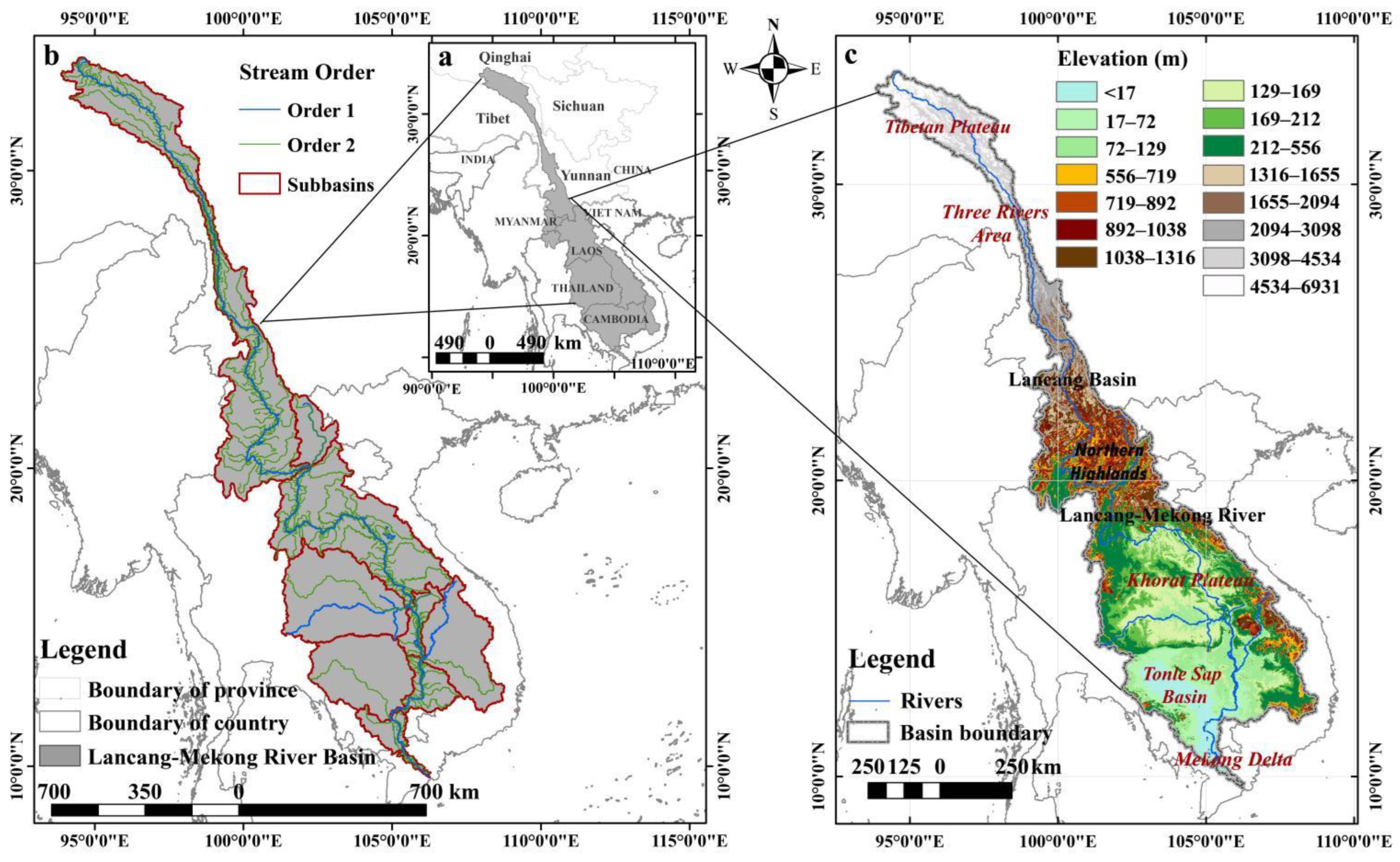
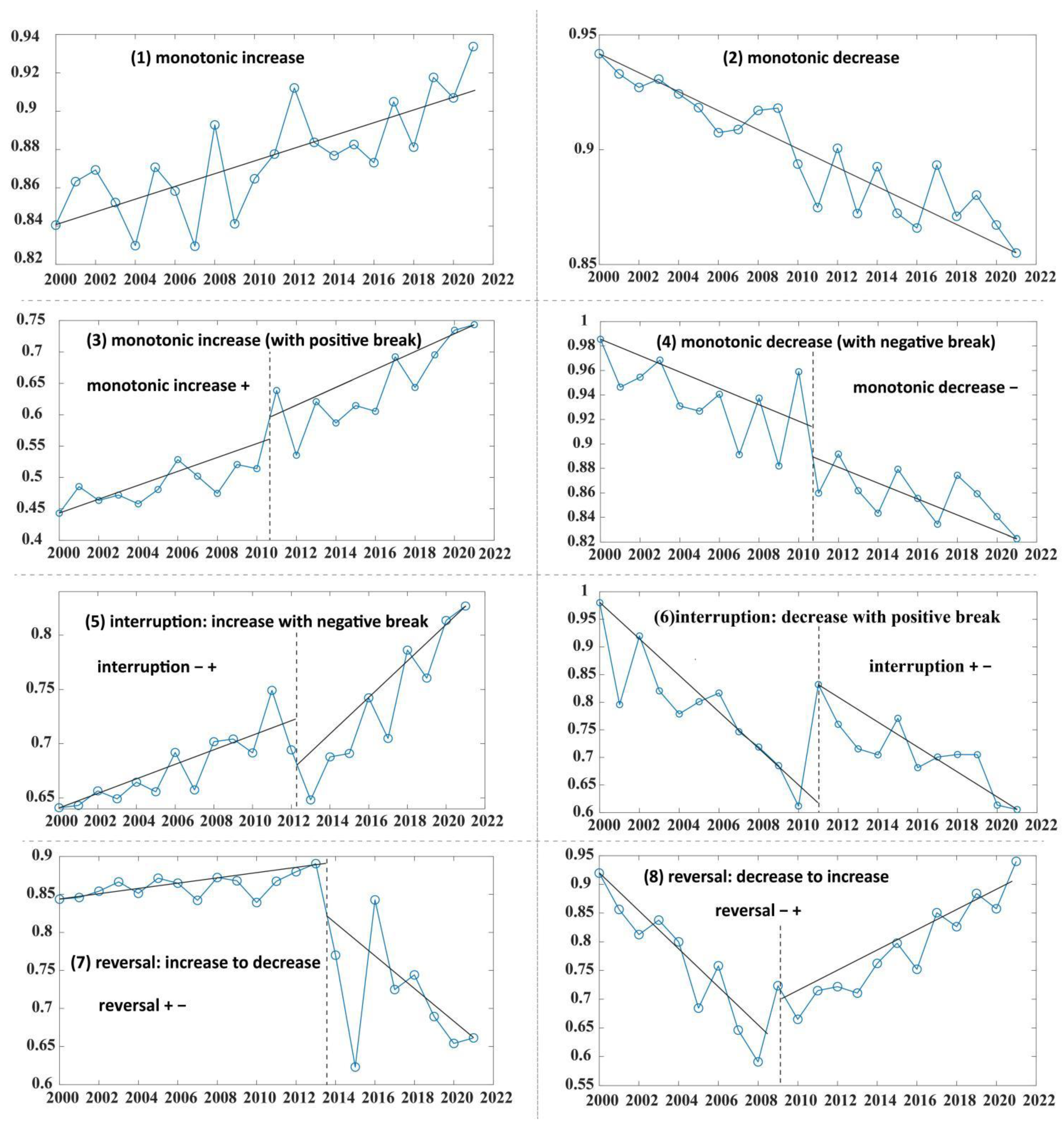



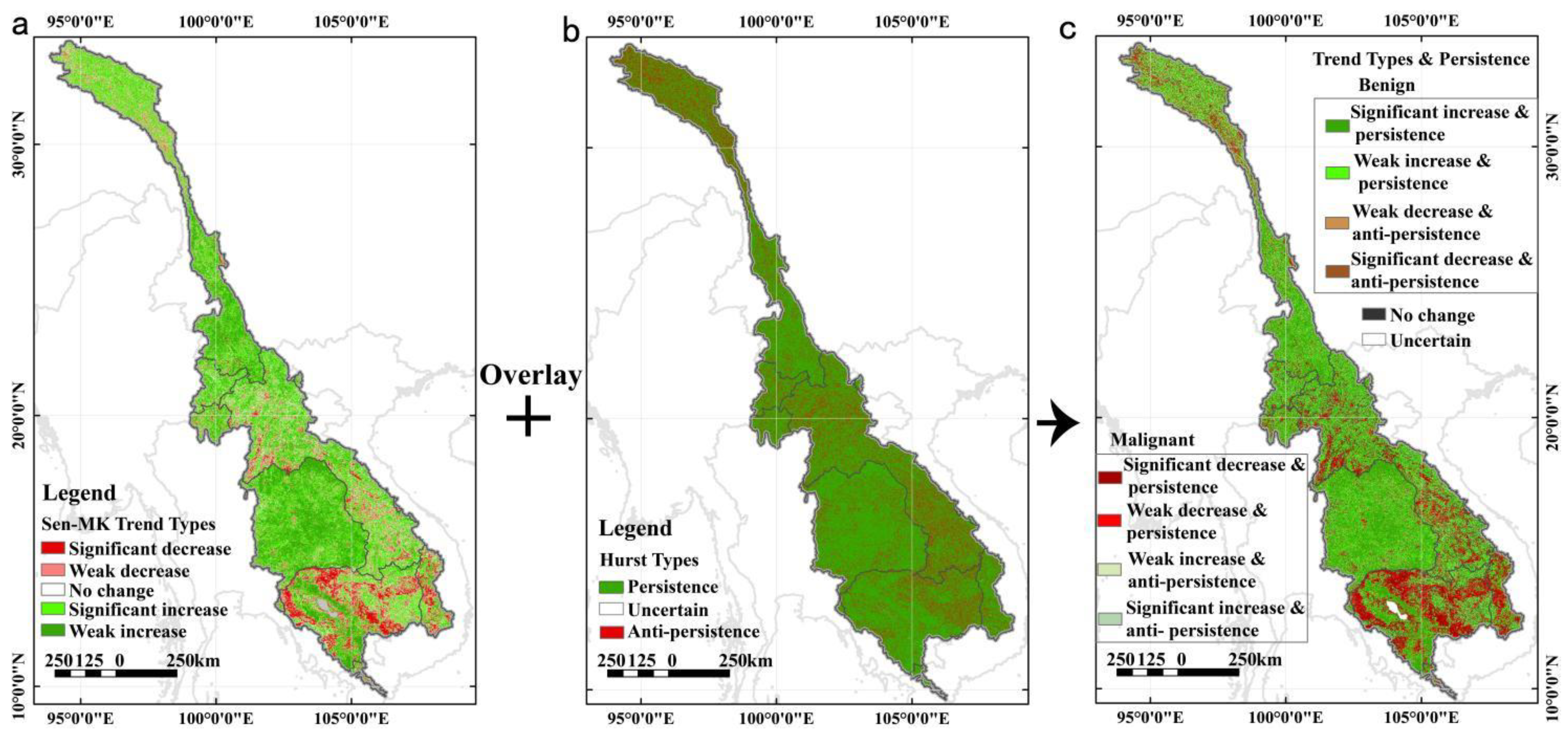


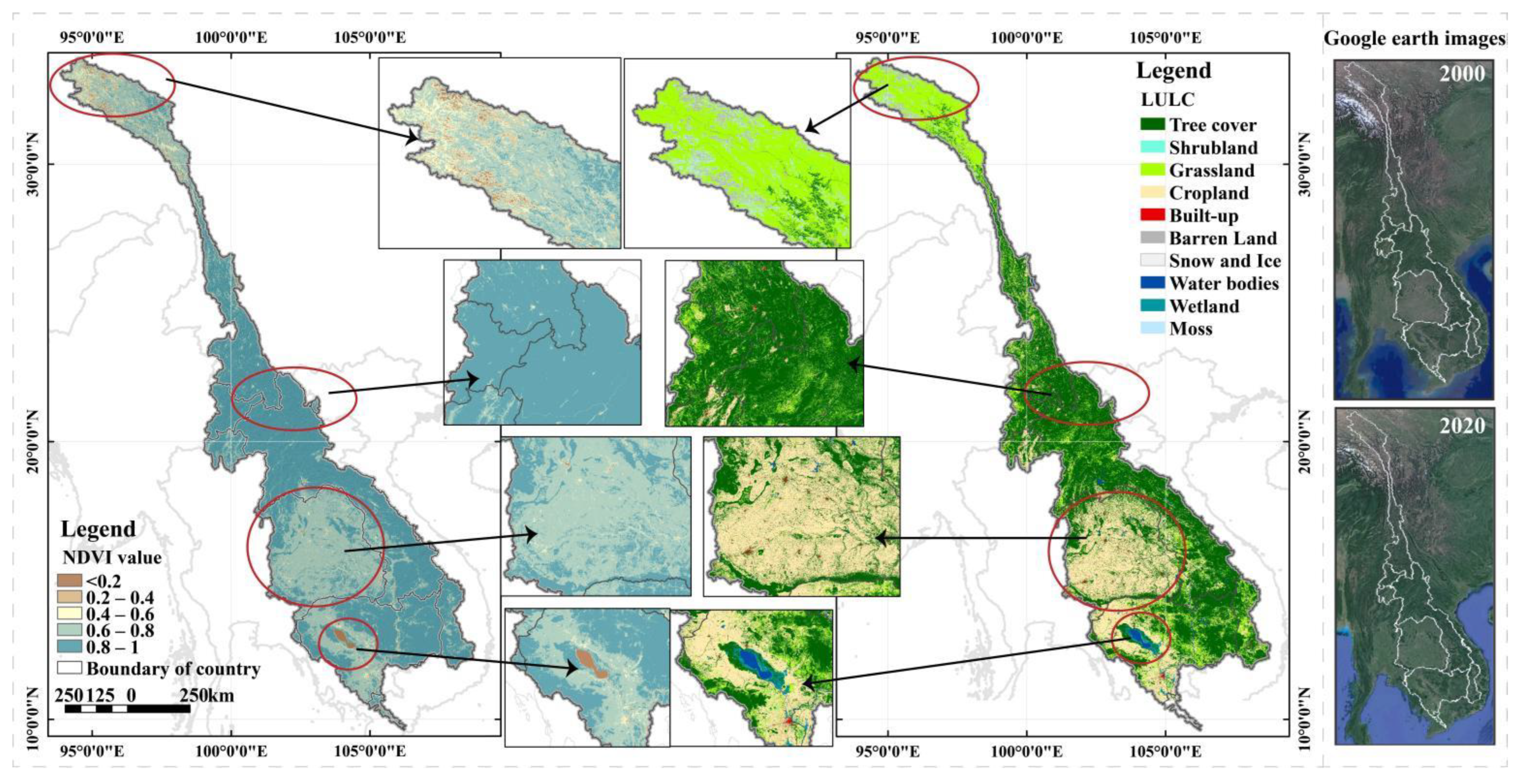
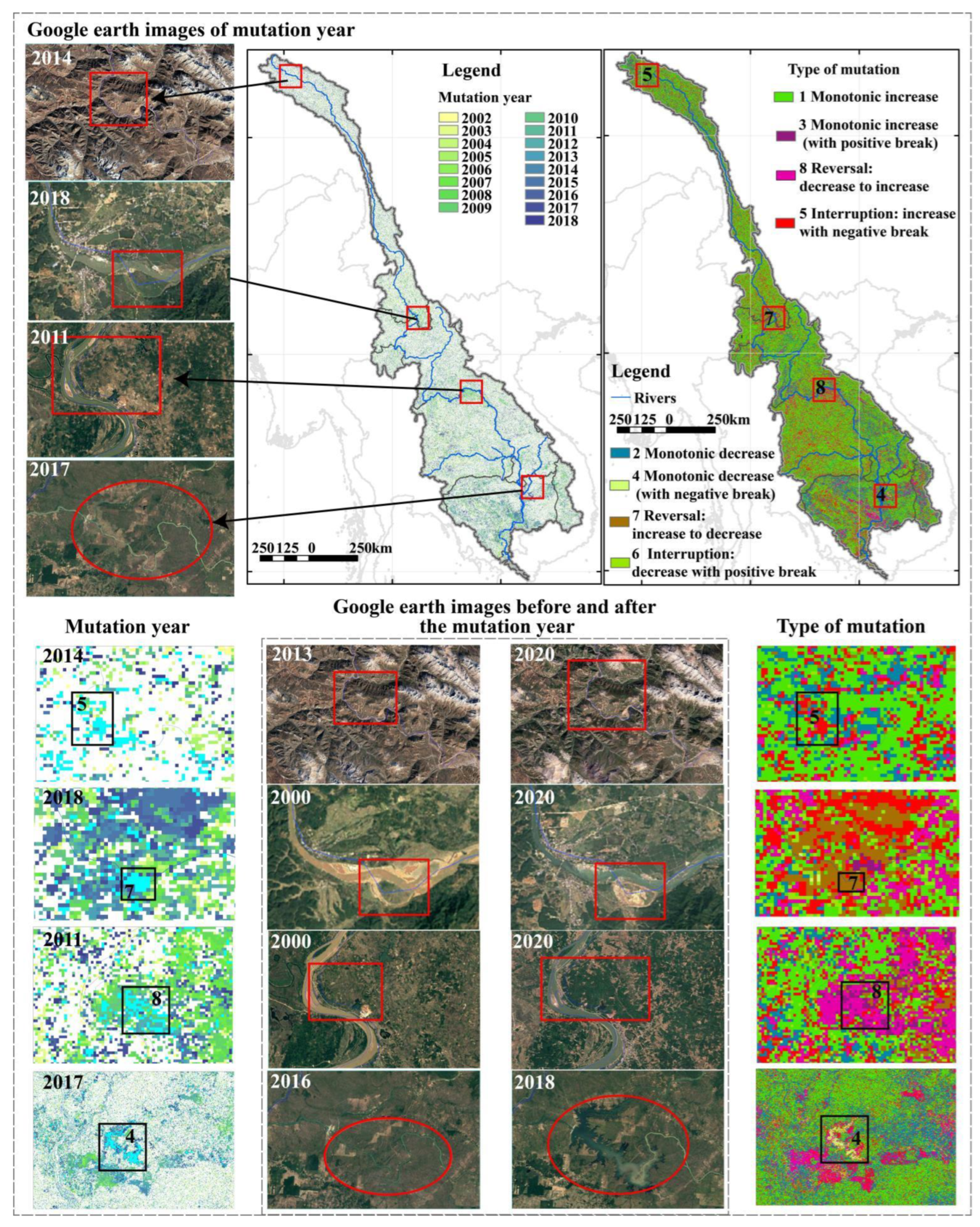
| Name and Description | Spatial Resolution | Data Sources |
|---|---|---|
| MODIS NDVI data | 250 m | Google Earth Engine(https://earthengine.google.com/, accessed on 18 June 2022)Original data website: https://lpdaac.usgs.gov/products/ ( accessed on 18 June 2022) |
| DEM data | 30 m | Geospatial Data Cloud (http://www.gscloud.cn, accessed on 18 June 2022) |
| 2020 LULC Products | 10 m | Google Earth Engine(https://earthengine.google.com/, accessed on 18 June 2022)Original data website: https://esa-worldcover.org/en (accessed on 18 June 2022) |
| Watershed Boundary Data | 15 arc-second resolution | HydroSHEDS website (https://www.hydrosheds.org/, accessed on 9 June 2022) |
| Administrative division data | 1:1 million | Resource and Environment Science and Data Center of Chinese Academy of Sciences (http://www.resdc.cn, accessed on 1 June 2022) |
| SNDVI | Z Value | Sen-MK Trend Type |
|---|---|---|
| Increase region SNDVI ≥ 0.0005 | Significant Z ≥ 1.96 | Significant increase |
| Increase region SNDVI ≥ 0.0005 | Insignificant −1.96 < Z < 1.96 | Weak increase |
| No change −0.0005 < SNDVI < 0.0005 | Insignificant −1.96 < Z < 1.96 | No change |
| Decrease region SNDVI < 0.0005 | Insignificant −1.96 < Z < 1.96 | Weak decrease |
| Decrease region SNDVI < 0.0005 | Significant Z < −1.96 | Significant decrease |
| Type name | Meanings |
|---|---|
| (1) monotonic increase | No obvious mutation was detected, and the overall trend showed a monotonic increase |
| (2) monotonic decrease | No obvious mutation was detected, and the overall trend showed a monotonic decrease |
| (3) monotonic increase (with positive break) | One obvious mutation was detected, and the value at the breakpoint suddenly increased, and the overall trend showed a monotonic increase. Represented by the symbol “monotonic increase+”. |
| (4) monotonic decrease (with negative break) | One obvious mutation was detected, and the value at the breakpoint suddenly decreased, and the overall trend showed a monotonic decrease. Represented by the symbol “monotonic decrease−”. |
| (5) interruption: increase with negative break | One obvious mutation was detected, and the value at the breakpoint suddenly decreased, and the trend showed a significant increase with significant negative break followed by significant increase. Represented by the symbol “interruption−+”. |
| (6) interruption: decrease with positive break | One obvious mutation was detected, and the value at the breakpoint suddenly increased, and the trend showed a significant decrease with significant positive break followed by significant decrease. Represented by the symbol “interruption+−”. |
| (7) reversal: increase to decrease | One obvious mutation was detected, with a trend of switching from a significant increase to a significant decrease. Represented by the symbol “ reversal+−”. |
| (8) reversal: decrease to increase | One obvious mutation was detected, with a trend of switching from a significant decrease to a significant increase. Represented by the symbol “ reversal−+”. |
| Year | Vegetation Type | 2021 | ||||
|---|---|---|---|---|---|---|
| Low Vegetation Cover | Relatively Low Vegetation | Medium Vegetation Coverage | Relatively High Vegetation Coverage | High Vegetation Coverage | ||
| 2000 | Low vegetation cover | 49.33 | 36.80 | 7.40 | 4.80 | 1.67 |
| Relatively low vegetation coverage | 6.13 | 37.69 | 34.75 | 16.58 | 4.85 | |
| Medium vegetation coverage | 0.30 | 3.89 | 26.75 | 58.83 | 10.23 | |
| Relatively high vegetation coverage | 0.30 | 0.17 | 2.65 | 45.91 | 51.23 | |
| High vegetation coverage | 0.04 | 0.41 | 0.41 | 22.70 | 76.44 | |
| Development Direction | Hurst Sustainability | Sen MK Trend Type | Trend and Persistence Types | Number of Grids/Piece | Total/Piece | Proportion/% | Total Proportion/% |
|---|---|---|---|---|---|---|---|
| Benign | Persistence 0.5 < H < 1 | weak increase | weak increase and persistence | 3,659,827 | 7,456,410 | 29.52 | 60.14 |
| significant increase | significant increase and persistence | 3,460,548 | 27.91 | ||||
| anti-persistence 0 < H < 0.5 | significant decrease | significant decrease and anti-persistence | 22,285 | 0.18 | |||
| weak decrease | weak decrease and anti-persistence | 313,750 | 2.53 | ||||
| Malignant | Persistence 0.5 < H < 1 | significant decrease | significant decrease and persistence | 735,276 | 3,135,665 | 5.93 | 25.29 |
| weak decrease | weak decrease and persistence | 1,290,168 | 10.41 | ||||
| anti-persistence 0 < H < 0.5 | weak increase | weak increase and anti-persistence | 978,299 | 7.89 | |||
| significant increase | significant increase and anti-persistence | 131,922 | 1.06 | ||||
| Uncertain | Uncertain H = 0.5 | no change | uncertain | 4487 | 4487 | 0.04 | 0.04 |
| no change | no change | 1,801,105 | 1,801,105 | 14.53 | 14.53 |
| Type of Mutation | The Proportion of Area in the Year When Each Trend Changed (%) | Total | ||||
|---|---|---|---|---|---|---|
| 2002–2004 | 2005–2007 | 2008–2010 | 2011–2013 | 2014–2018 | ||
| monotonic increase | - | - | - | - | - | - |
| monotonic decrease | - | - | - | - | - | - |
| monotonic increase+ | 0.29 | 0.19 | 0.24 | 0.19 | 0.40 | 1.31 |
| monotonic decrease− | 0.06 | 0.03 | 0.05 | 0.10 | 0.41 | 0.65 |
| interruption−+ | 11.57 | 6.57 | 4.79 | 3.75 | 9.86 | 36.54 |
| interruption+− | 1.59 | 2.04 | 3.37 | 5.19 | 6.99 | 19.19 |
| reversal+− | 1.99 | 1.64 | 2.53 | 3.91 | 7.74 | 17.80 |
| reversal−+ | 6.73 | 3.96 | 4.22 | 3.76 | 5.85 | 24.51 |
| Total | 22.21 | 14.44 | 15.19 | 16.91 | 31.25 | 100.00 |
| BFAST01 | Monotonic Increase | Monotonic Decrease | Monotonic Increase+ | Monotonic Decrease− | Interruption−+ | Interruption+− | Reversal+− | Reversal−+ | |
|---|---|---|---|---|---|---|---|---|---|
| Sen Trend | |||||||||
| Decrease | 1.30 | 55.06 | 0.00 | 1.21 | 8.34 | 12.92 | 8.49 | 12.68 | |
| No change | 36.51 | 31.16 | 0.00 | 0.00 | 12.04 | 8.83 | 4.70 | 6.76 | |
| Increase | 65.46 | 0.86 | 0.69 | 0.00 | 14.38 | 4.63 | 5.99 | 7.99 | |
Publisher’s Note: MDPI stays neutral with regard to jurisdictional claims in published maps and institutional affiliations. |
© 2022 by the authors. Licensee MDPI, Basel, Switzerland. This article is an open access article distributed under the terms and conditions of the Creative Commons Attribution (CC BY) license (https://creativecommons.org/licenses/by/4.0/).
Share and Cite
Zhong, X.; Li, J.; Wang, J.; Zhang, J.; Liu, L.; Ma, J. Linear and Nonlinear Characteristics of Long-Term NDVI Using Trend Analysis: A Case Study of Lancang-Mekong River Basin. Remote Sens. 2022, 14, 6271. https://doi.org/10.3390/rs14246271
Zhong X, Li J, Wang J, Zhang J, Liu L, Ma J. Linear and Nonlinear Characteristics of Long-Term NDVI Using Trend Analysis: A Case Study of Lancang-Mekong River Basin. Remote Sensing. 2022; 14(24):6271. https://doi.org/10.3390/rs14246271
Chicago/Turabian StyleZhong, Xuzhen, Jie Li, Jinliang Wang, Jianpeng Zhang, Lanfang Liu, and Jun Ma. 2022. "Linear and Nonlinear Characteristics of Long-Term NDVI Using Trend Analysis: A Case Study of Lancang-Mekong River Basin" Remote Sensing 14, no. 24: 6271. https://doi.org/10.3390/rs14246271
APA StyleZhong, X., Li, J., Wang, J., Zhang, J., Liu, L., & Ma, J. (2022). Linear and Nonlinear Characteristics of Long-Term NDVI Using Trend Analysis: A Case Study of Lancang-Mekong River Basin. Remote Sensing, 14(24), 6271. https://doi.org/10.3390/rs14246271






